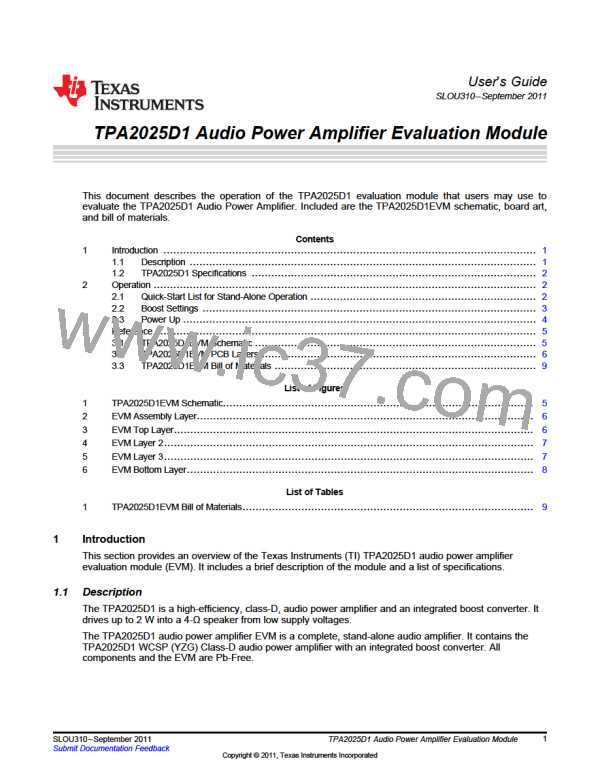Operation
www.ti.com
ΔIL is inversely proportional to L. Minimize ΔIL as much as is necessary for a specific application. Increase
the inductance to reduce the ripple current. Note that making the inductance too large prevents the boost
converter from responding to fast load changes properly. Typical inductor values for the TPA2025D1 are
2.2 μH to 4.7 μH.
Select an inductor with a small dc resistance, DCR. DCR reduces the output power due to the voltage
drop across the inductor.
2.2.3
Changing the Boost Capacitor
The value of the boost capacitor is determined by the minimum value of working capacitance required for
stability and the maximum voltage ripple allowed on PVOUT in the application. The minimum value of
working capacitance is 4.7 μF. Do not use any component with a working capacitance less than 4.7 μF.
Working capacitance is defined as the rated capacitance reduced by the DC Bias factor, temperature, and
aging parameters of the capacitor being used. It may be necessary to request these parameters from the
capacitor manufacturer. For best performance, only consider ceramic capacitors with X5R or X7R
dielectric.
For X5R or X7R ceramic capacitors, Equation 3 shows the relationships among the boost capacitance, C,
to load current, load voltage, ripple voltage, input voltage, and switching frequency (IPVOUT, PVOUT, ΔV,
VDD, fboost respectively). Insert the maximum allowed ripple voltage into Equation 3 to solve for C. A factor
of about 1.5 is included to account for capacitance loss due to dc voltage and temperature.
I
´ (PVDD - VBAT)
PVDD
C = 1.5 ´
DV ´ f
´ PVDD
BOOST
(3)
For aluminum or tantalum capacitors, Equation 4 shows the relationships among the boost capacitance,
C, to load current, load voltage, ripple voltage, input voltage, and switching frequency (IPVOUT, PVOUT, ΔV,
VDD, fboost respectively). Insert the maximum allowed ripple voltage into Equation 4 to solve for C. Solve
this equation assuming ESR is zero.
I
´ (PVDD - VBAT)
PVDD
C =
DV ´ f
´ PVDD
BOOST
(4)
Capacitance of aluminum and tantalum capacitors is normally insensitive to applied voltage, so no factor
of 1.5 is included in Equation 4. However, the ESR in aluminum and tantalum capacitors can be
significant. Choose an aluminum or tantalum capacitor with an ESR around 30 mΩ. For best performance
with tantalum capacitors, use at least a 10-V rating. Note that tantalum capacitors must generally be used
at voltages of half their ratings or less.
2.3 Power Up
1. Verify that the correct connections are as described in Section 2.1.
2. Verify that the voltage setting of the power supply is between 2.5 V and 5.2 V, and turn on the power
supply. Proper operation of the EVM begins.
3. Adjust the audio signal source as needed.
4
TPA2025D1 Audio Power Amplifier Evaluation Module
SLOU310–September 2011
Submit Documentation Feedback
Copyright © 2011, Texas Instruments Incorporated

 TI [ TEXAS INSTRUMENTS ]
TI [ TEXAS INSTRUMENTS ]